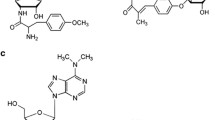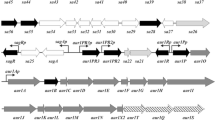Abstract
Thed-alanine:d-alanine-ligase-related enzymes can have three preferential substrate specificities. Usually, these enzymes synthesized-alanyl-d-alanine. In vancomycin-resistant Gram-positive bacteria, structurally related enzymes synthesized-alanyl-d-lactate or Dalanyl-d-serine. The sequence of internal fragments of eight structurald-alanine:d-alanine ligase genes from enterococci has been determined. Alignment of the deduced amino acid sequences with those of other related enzymes from Gram-negative and Gram-positive bacteria revealed the presence of four distinct sequence patterns in the putative substrate-binding sites, each correlating with specificity to a particular substrate (d-alanine:d-lactate ligases exhibited two patterns). Phylogenetic analysis showed different clusters. The enterococcal subtree was largely superimposable on that derived from 16S rRNA sequences. In lactic acid bacteria, structural divergence due to differences in substrate specificity was observed. Glycopeptide resistance proteins VanA and VanB, the VanC-type ligases, and Dd1A and DdlB from enteric bacteria andHaemophilus influenzae constituted separate clusters.
Similar content being viewed by others
References
Ausubel FM, Brent R, Kingston RE, Moore DD, Seidman JG, Smith JA, Struhl K (1987) Current protocols in molecular biology. John Wiley & Sons, New York
Billot-Klein D, Gutmann L, Sablé S, Guittet E, van Heijenoort J (1994) Modification of peptidoglycan precursors is a common feature of the low-level vancomycin-resistant VANB-typeEnterococcus D366 and of the naturally glycopeptide-resistant speciesLactobacillus casei, Pediococcus pentosaceus, Leuconostoc mesenteroides, andEnterococcus gallinarum. J Bacteriol 176:2398–2405
Bugg TDH, Wright GD, Dutka-Malen S, Arthur M, Courvalin P, Walsh CT (1991) Molecular basis for vancomycin resistance inEnterococcus faecium BM4147: biosynthesis of a depsipeptide peptidoglycan precursor by vancomycin resistance proteins VanH and VanA. Biochemistry 30:10408–10415
Collins MD, Rodrigues U, Ash C, Aguirre M, Farrow JAE, Martinez-Murcia A, Phillips BA, Williams AM, Wallbanks S (1991) Phylogenetic analysis of the genusLactobacillus and related lactic acid bacteria as determined by reverse transcriptase sequencing of 16S rRNA. FEMS Microbiol Lett 77:5–12
Daub E, Zawadzke LE, Botstein D, Walsh CT (1988) Isolation, cloning, and sequencing of theSalmonella typhimurium ddIA gene with purification and characterization of its product,d-alanine:d-alanine ligase (ADP-forming). Biochemistry 27:3701–3708
Devriese LAV, Pot B, Collins MD (1993) Phenotypic identification of the genusEnterococcus and differentiation of phylogenetically distinct enterococcal species and species groups. J Appl Bacteriol 75:399–408
Dutka-Malen S, Molinas C, Arthur M, Courvalin P (1990) The VANA glycopeptide resistance protein is related tod-alanyl-d-alanine ligase cell wall biosynthesis enzymes. Mol Gen Genet 224:364–372
Dutka-Malen S, Molinas C, Arthur M, Courvalin P (1992) Sequence of thevanC gene ofEnterococcus gallinarum BM4174 encoding ad-alanine:d-alanine ligase related protein necessary for vancomycin resistance. Gene 112:53–58
Elisha BG, Courvalin P (1995) Analysis of genes encodingd-alanine:d-alanine ligase related enzymes inLeuconostoc mesenteroides andLactobacillus spp. Gene 152:79–83
Evers S, Courvalin P (1996) Regulation of VanB-type vancomycin resistance gene expression by the VanSB- VanRB two-component regulatory system inEnterococcus faecalis V583. J Bacteriol 178:1302–1309
Fan C, Moews PC, Walsh CT, Knox JR (1994) Vancomycin resistance: structure ofd-alanine:d-alanine ligase at 2.3 Å resolution. Science 266:439–443
Felsenstein J (1985) Confidence limits on phylogenies: an approach using the bootstrap. Evolution 39:783–791
Felsenstein J (1993) PHYLIP version 3.5c. University of Washington, Seattle
Feng DF, Doolittle RF (1990) Progressive alignment and phylogenetic tree construction of protein sequences. Methods Enzymol 183:375–387
Fitch W (1971) Toward defining the course of evolution: minimum change for a specified tree topology. Syst Zool 20:406–416
Fleischmann RD, Adams MD, White O, Clayton RA, Kirkness EF et al. (1995) Whole-genome random sequencing and assembly ofHaemophilus influenzae Rd. Science 269:496–512
Handwerger S, Pucci MJ, Volk KJ, Liu J, Lee M (1994) VancomycinresistantLeuconostoc mesenteroides andLactobacillus casei synthesize cytoplasmic peptidoglycan precursors that terminate in lactate. J Bacteriol 176:260–264
Klare I, Heier H, Claus H, Reissbrodt R, Witte W (1995)vanA-mediated high-level glycopeptide resistance inEnterococcus faecium from animal husbandry. FEMS Microbiol Lett 125:165–172
Le Bouguénec C, Cespédès G, Horaud T (1990) Presence of chromosomal elements resembling the composite structure Tn3701 in streptococci. J Bacteriol 172:727–734
Meziane-Cherif D, Badet-Denisot M-A, Evers S, Courvalin P, Badet B (1994) Purification and characterization of the VanB ligase associated with type B vancomycin resistance inEnterococcus faecalis V583. FEBS Lett 354:140–142
Navarro F, Courvalin P (1994) Analysis of genes encodingd-alanine:d-alanine ligase related enzymes inEnterococcus casseliflavus andEnterococcus flavescens. Antimicrob Agents Chemother 38:1788–1793
Reynolds PE (1989) Structure, biochemistry and mechanism of action of glycopeptide antibiotics. Eur J Clin Microbiol Infect Dis 8:943–950
Reynolds PE, Snaith HM, Maguire AJ, Dutka-Malen S, Courvalin P (1994) Analysis of peptidoglycan precursors in vancomycin resistantEnterococcus gallinarum BM4174. Biochem J 301:5–8
Saitou N, Nei M (1987) The neighbor-joining method: a new method for reconstructing phylogenetic trees. Mol Biol Evol 4:406–425
Sanger F, Nicklen S, Coulson AR (1977) DNA sequencing with chain-terminating inhibitors. Proc Natl Acad Sci USA 74:5463–5467
Shi Y, Walsh CT (1995) Active site mapping ofEscherichia coli dAla:d-Ala ligase by structure-based mutagenesis. Biochemistry 34: 2768–2776
Triglia T, Peterson MG, Kemp DJ (1988) A procedure forin vitro amplification of DNA segments that lie outside the boundaries of known sequences. Nucleic Acids Res 16:8186
Van der Auwera P, Pensart N, Korten V, Murray BE, Leclercq R (1996) Influence of oral glycopeptides (vancomycin and teicoplanin) on the fecal flora of human volunteers: selection of highlyglycopeptide-resistant strains. J Infect Dis (in press)
Walsh CT (1989) Enzymes in thed-alanine branch of bacterial cell wall peptidoglycan assembly. J Biol Chem 264:2393–2396
Yanisch-Perron C, Vieira J, Messing J (1985) Improved M13 phage cloning vectors and host strains: nucleotide sequences of the M13mp18 and pUC19 vectors. Gene 33:103–119
Zawadzke LE, Bugg TDH, Walsh CT (1991) Existence of twod-alanine:d-alanine ligases inEscherichia coli: cloning and sequencing of theddIA gene, and purification and characterization of the DdlA and DdlB enzymes. Biochemistry 30:1673–1682
Author information
Authors and Affiliations
Additional information
Correspondence to: P. Courvalin
Rights and permissions
About this article
Cite this article
Evers, S., Casadewall, B., Charles, M. et al. Evolution of structure and substrate specificity ind-alanine:d-Alanine ligases and related enzymes. J Mol Evol 42, 706–712 (1996). https://doi.org/10.1007/BF02338803
Received:
Accepted:
Issue Date:
DOI: https://doi.org/10.1007/BF02338803




